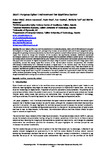Multi-Purpose Cyber Environment for Maritime Sector
| dc.contributor.author | Visky, G | |
| dc.contributor.author | Lavrenovs, A | |
| dc.contributor.author | Orye, E | |
| dc.contributor.author | Heering, D | |
| dc.contributor.author | Tam, K | |
| dc.date.accessioned | 2022-04-25T09:26:16Z | |
| dc.date.available | 2022-04-25T09:26:16Z | |
| dc.date.issued | 2022 | |
| dc.identifier.issn | 2048-9870 | |
| dc.identifier.issn | 2048-9889 | |
| dc.identifier.uri | http://hdl.handle.net/10026.1/19056 | |
| dc.description.abstract |
<jats:p>The cyber attack surface in a maritime environment is constantly growing. More current information and computer technologies are being used on cargo and passenger ships to save on operational costs and increase navigational safety. Along with the growing reliance on automation, the risk of a disruption to a vessel's critical systems by drawing on the wrong inputs from sensors to change the behaviour of the actuators has significantly increased. Traditional operational technological systems are much more complicated to update than the automatic software updates we see in information technology systems. To better understand existing cyber threats in the maritime sector and increase cybersecurity resilience, this paper aims to replicate the digital components of a ship's bridge to examine scenarios when the bridge system loses connectivity, receives the wrong inputs from sensors, or the internal system becomes compromised. The simulator differentiates fundamentally from traditional simulators or digital twins in the maritime sector that focus on training seafarers. This environment generates data streams that are similar to those on board a ship. Those data streams can be analysed, modified and spoofed to observe the effects. The effects can be technical but it is equally necessary to analyse how human beings would react in specific circumstances. Our work provides the opportunity to isolate the ship network traffic, conduct penetration testing, find cybersecurity vulnerabilities on devices, and execute cyber attacks without the dangers associated with running such scenarios on a vessel in the open sea.</jats:p> | |
| dc.format.extent | 349-357 | |
| dc.language.iso | en | |
| dc.publisher | Academic Conferences International Ltd | |
| dc.subject | maritime | |
| dc.subject | cybersecurity | |
| dc.subject | testbed | |
| dc.title | Multi-Purpose Cyber Environment for Maritime Sector | |
| dc.type | journal-article | |
| plymouth.author-url | https://www.webofscience.com/api/gateway?GWVersion=2&SrcApp=PARTNER_APP&SrcAuth=LinksAMR&KeyUT=WOS:000833469700040&DestLinkType=FullRecord&DestApp=ALL_WOS&UsrCustomerID=11bb513d99f797142bcfeffcc58ea008 | |
| plymouth.issue | 1 | |
| plymouth.volume | 17 | |
| plymouth.publication-status | Published online | |
| plymouth.journal | International Conference on Cyber Warfare and Security | |
| dc.identifier.doi | 10.34190/iccws.17.1.26 | |
| plymouth.organisational-group | /Plymouth | |
| plymouth.organisational-group | /Plymouth/Faculty of Science and Engineering | |
| plymouth.organisational-group | /Plymouth/Faculty of Science and Engineering/School of Engineering, Computing and Mathematics | |
| plymouth.organisational-group | /Plymouth/REF 2021 Researchers by UoA | |
| plymouth.organisational-group | /Plymouth/REF 2021 Researchers by UoA/UoA11 Computer Science and Informatics | |
| plymouth.organisational-group | /Plymouth/Users by role | |
| plymouth.organisational-group | /Plymouth/Users by role/Academics | |
| dc.identifier.eissn | 2048-9889 | |
| dc.rights.embargoperiod | Not known | |
| rioxxterms.versionofrecord | 10.34190/iccws.17.1.26 | |
| rioxxterms.licenseref.uri | http://www.rioxx.net/licenses/all-rights-reserved | |
| rioxxterms.type | Journal Article/Review |


